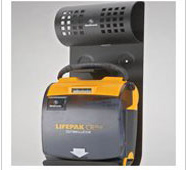 The health and wellbeing of our staff and students is a priority.
The health and wellbeing of our staff and students is a priority.
In addition to the numerous services we provide, eight fully Automated External Defibrillator’s (AEDs) have recently been located around both Talbot and Lansdowne Campus.
An AED is a portable device that checks the heart rhythm in the event of sudden cardiac arrest and, if needed, can send an electric shock to the heart to try and restore a normal rhythm.
These units are easy to use and clear instructions are provided, but to support this initiative defibrillator training is being held over the coming months.
Students are encouraged to participate in these sessions, which not only provide an invaluable life skill, but could also ultimately save someone’s life.
To book onto a session, please email the Health, Safety and Wellbeing Team indicating which session you would like to attend;
Thursday 2 October, 12.30pm – 4.30pm, CG07, Christchurch House, Talbot
Tuesday 14 October, 9am – 1pm, R207, Royal London House, Lansdowne
Friday 31 October, 12.30pm – 4.30pm, CG06, Christchurch House, Talbot
Tuesday 11 November, 9am – 1pm, R303, Royal London House, Lansdowne
Monday 24 November, 12.30pm – 4.30pm, R303, Royal London House, Lansdowne
Tuesday 9 December, 9am – 1pm, R302, Royal London House, Lansdowne
Wednesday 10 December, 9am – 1pm, P401, Poole House, Talbot
Thursday 18 December, 12.30pm – 4.30, R303, Royal London House, Lansdowne
The Defibrillators are located at;
Talbot Campus
Poole House [Main Reception]
SportBU [Reception]
Talbot House [External Main Entrance]
Christchurch House [Main Entrance Porch]
Lansdowne Campus
Studland House [Main Reception]
Executive Business Centre [Reception Area]
Bournemouth House [Reception Area]
Purbeck House/Melbury House [Entrance Lobby]
 Bournemouth University
Bournemouth University